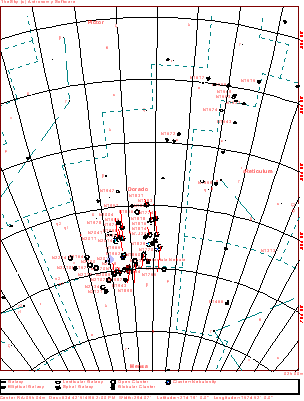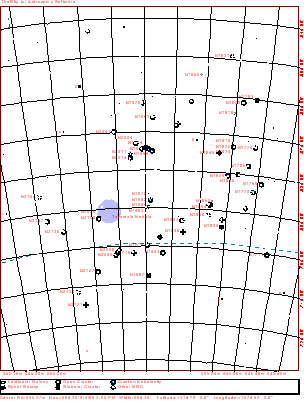
| Home | Deepsky Atlas | TheAstronews | Links | Solar System | ||||||

Hawaiian Astronomical SocietyConstellations: Dorado -- What Hawaiians call the Mahi-mahi |
||||||||||
An alternate, and archaic name for the constellation was Xiphias, or swordfish. This name first appeared in the Johannes Kepler's Rudolphine Tables of 1627. These tables were significant for two reasons: They contained accurate positions for naked eye stars visible from northern Europe derived from Tycho Brahe's observations. They also contained tables of planetary motion based on two assumptions: that all planets orbited the sun, and that their orbits were elliptical. The first assumption, heliocentrism, Kepler inherited from Copernicus. The second Kepler discovered for himself, when trying to derive a formula for Mars' orbit that actually worked. The sheer simplicity of Kepler's formulas probably contributed more than anything else to the overthrow of the earth centered (geocentric) view of the universe, so dominant until then.

Click the map for a 909x1199 version of the above. Click here for a map better suited for use in the field.

This a more detailed view of the constellation. The map displays stars to magnitude 10, and deepsky objects to magnitude 12. Click here for a map better suited for use in the field.

Click here for a map better suited for use in the field.
 88k Labeled JPEG Fifth magnitude Nu Doradus anchors this region of Large Magellanic Cloud open clusters east of the Tarantula Nebula. NGC2214 (Bennett 36) lies 41' NNE of the star (mag. 11). NGC2210 (mag. 10.2, 1.7') lies 23' south-east of the star. NGC2164 (mag. 10) lies 58' WNW of Nu Doradus, while NGC2157 (mag. 10) lies. 1.1° WSW. The galaxy pair NGC2187 and NGC2187a lie at the limit of an 8"-10" telescope. Dreyer offers this description for both: Pretty bright (mag. 13.3), pretty small (2.0'x1.2'), round, gradually brighter middle, double nebula (companion very faint, round, gradually little brighter middle). They lie 53' south-west of Nu. 88k Labeled JPEG Fifth magnitude Nu Doradus anchors this region of Large Magellanic Cloud open clusters east of the Tarantula Nebula. NGC2214 (Bennett 36) lies 41' NNE of the star (mag. 11). NGC2210 (mag. 10.2, 1.7') lies 23' south-east of the star. NGC2164 (mag. 10) lies 58' WNW of Nu Doradus, while NGC2157 (mag. 10) lies. 1.1° WSW. The galaxy pair NGC2187 and NGC2187a lie at the limit of an 8"-10" telescope. Dreyer offers this description for both: Pretty bright (mag. 13.3), pretty small (2.0'x1.2'), round, gradually brighter middle, double nebula (companion very faint, round, gradually little brighter middle). They lie 53' south-west of Nu.
Image is a four image mosaic from the Digital Sky Survey covering roughly 1.75° of sky.
|
Offset from the center of the LMC is the Tarantula Nebula (NGC2070, Bennett 35, Caldwell 103). This is the only extragalactic nebula visible to the unaided eye and is striking when seen in medium to large telescopes. Measurements indicate that this nebula is actually the core of the LMC even though it appears to be off-center (on the SE side of the LMC) from the rest of the galaxy. One of Dreyer's extremely remarkable objects, it is very bright (mag. 8.3), very large (5') and strongly looped in appearance.
The associated cluster with this nebulosity is called the 30 Doradus cluster.
 78k JPEG Image taken by Christian Buil at Reunion Island. Large Magellanic Cloud. Used 80mm F3/5. 78k JPEG Image taken by Christian Buil at Reunion Island. Large Magellanic Cloud. Used 80mm F3/5.
|
Image on the left is from the Digital Sky Survey. The color image on the right is a composite of NGCs 1866 and 2298 in (Puppis). S�ren Larsen took the pictures of the open and globular cluster and combined them to demonstrate the difference between the cluster types. NGC1866 is a young (100 million years is young for a cluster) object, full of hot blue stars. NGC2298 may exceed 10 billion years. Only small, slow burning, red stars survive that long.
|
 101k JPEG NGC1850 dominates the open clusters in this section of the LMC, and is one of Dreyer's remarkable objects. It is very bright (9.3),large (3.4'), very much condensed, and very resolvable. If you can see stars to mag. 25, you should see over 10,000 of them. The Hubble Space Telescope is one such scope that can, and it reports that 1850 consists of 3 clusters in our line of sight.
101k JPEG NGC1850 dominates the open clusters in this section of the LMC, and is one of Dreyer's remarkable objects. It is very bright (9.3),large (3.4'), very much condensed, and very resolvable. If you can see stars to mag. 25, you should see over 10,000 of them. The Hubble Space Telescope is one such scope that can, and it reports that 1850 consists of 3 clusters in our line of sight.
NGC1865 is very faint, fairly large, and it brightens slightly toward the middle.
Dreyer calls NGC1860 faint, fairly large, round, and brightening slightly toward the middle.
NGC1858 is bright, large, and slightly elongated with two nuclei. Dreyer sees nebulosity involved.
NGC1856 is an open cluster described as bright (mag. 10), fairly large (12" in right ascension), round, and gradually brightening toward the middle.
NGC1854 an open cluster that sits mid way between NGC1858 and NGC1850. It is quite bright (mag. 10.5), small, round, and brightening gradually toward the middle.
NGC1847 is bright, small, slightly elongated, with two brighter stars in the middle.
NGC1839 is described as a star plus nebulosity, fairly bright, irregular in shape, and the second object in a line of several.
NGC1836 is the first of a series of star plus nebulosity.
NGC1825 has no description.
Labeled image from the Digital Sky Survey.
| Map | Printable Map |
 38k labeled JPEG A complex of clusters plus nebulosity make up NGC1763 (Bennett 27) on the western side of the LMC (and on the west, or right, side of the image). Five other NGCs and two IC numbers flesh out this grouping. Dreyer describes the area as very bright, very large (25'), very irregular and much extended. It begins to shine in an 8". It should respond well to a nebula filter.
38k labeled JPEG A complex of clusters plus nebulosity make up NGC1763 (Bennett 27) on the western side of the LMC (and on the west, or right, side of the image). Five other NGCs and two IC numbers flesh out this grouping. Dreyer describes the area as very bright, very large (25'), very irregular and much extended. It begins to shine in an 8". It should respond well to a nebula filter.
On the east (left) side of the photograph sits the open (the NGC catalog describes it as a globular) cluster NGC1818 (Bennett 30). Dreyer calls it very bright (mag. 9.8), fairly large (3'), resolvable, very condensed, and perfectly round.
On the north-eastern (Top, left) side of the image sits another open cluster, NGC1805. Described as bright (mag. 10), very small, very suddenly brightening toward the middle, Dreyer claims there is nebulosity involved.
NGC1783 (Bennett 28) is the last prominent cluster, call it "globularish." It is quite bright (mag. 11), large, more or less round, gradually brightening to a very condensed core. Dreyer said it was resolvable.
Image from the Digital Sky Survey.
| Map | Printable Map | 318k JPEG |
 29k Labeled JPEG Fifth magnitude Kappa Doradus marks the launch point for a tour of three galaxies anchored by the barred spiral galaxy NGC1672 (Bennett 26), 24' to the NNE. Dreyer describes NGC1672 as bright (mag. 10.6), large (6.6'x5.5'), and having an abruptly much brighter nucleus. Telescopes as small as 12" may show spiral structure. A 20" shows the galaxy's bar. 29k Labeled JPEG Fifth magnitude Kappa Doradus marks the launch point for a tour of three galaxies anchored by the barred spiral galaxy NGC1672 (Bennett 26), 24' to the NNE. Dreyer describes NGC1672 as bright (mag. 10.6), large (6.6'x5.5'), and having an abruptly much brighter nucleus. Telescopes as small as 12" may show spiral structure. A 20" shows the galaxy's bar.
NGC1688 lies 30' east of Kappa Doradus. Dreyer calls it fairly bright (mag. 12.6), fairly large (2.4'x1.9'), irregularly round, and fairly gradually much brighter toward the middle. NGC1703 lies just over 1° east of Kappa Doradus. This one is described as faint (mag. 12.3), large (2.9' x 2.6'), round, and very gradually brightening toward the middle. There is a double star attached.
Image is a mosaic from two Digital Sky Survey downloads.
|
 78k JPEG The third magnitude Alpha Doradus serves as a starting point for a tour of galaxies in this portion of Dorado. NGC1617 (Bennett 25a) lies 33' north-west of the star. Dreyer describes it as bright (mag. 11.4), large (4.3'x2.1'), moderately extended (p.a. 106°), very gradually, then very abruptly much brighter toward a 5" nucleus. 78k JPEG The third magnitude Alpha Doradus serves as a starting point for a tour of galaxies in this portion of Dorado. NGC1617 (Bennett 25a) lies 33' north-west of the star. Dreyer describes it as bright (mag. 11.4), large (4.3'x2.1'), moderately extended (p.a. 106°), very gradually, then very abruptly much brighter toward a 5" nucleus.
The galaxy pair of NGCs 1602 (mag. 13.8, 1.9'x1.1') and 1596 (mag. 12.1, 3.7'x0.9') lie 52' west of Alpha Doradus and 43' south-west of NGC1617.
|
 40k labeled JPEG Moving 2° west of Alpha Doradus we come to an area that contains 5 galaxies easily visible with amateur telescopes. The largest and brightest is NGC1566 (Bennett 25), a spiral Seyfert. Described as very bright (mag. 10.1), large (8.5'x6.5'), with a small nucleus much brighter than the surrounding halo.
40k labeled JPEG Moving 2° west of Alpha Doradus we come to an area that contains 5 galaxies easily visible with amateur telescopes. The largest and brightest is NGC1566 (Bennett 25), a spiral Seyfert. Described as very bright (mag. 10.1), large (8.5'x6.5'), with a small nucleus much brighter than the surrounding halo.
NGC1596, an elliptical galaxy, lies 1.1° to the east. It is bright (mag. 12.1), fairly large (3.7'x.9'), much elongated (P.A. 20°), and possessing a small, bright nucleus. A fainter (mag. 13.8) companion (NGC1602) sits just out of the image.
Three bright spiral galaxies anchor the southwest (bottom, right) corner of the image. From north to south (top to bottom) these are: NGC1549 (Bennett 23). Described as bright (10.5), fairly small (4.9'x4.1'), round, with a bright nucleus. 13' to the south lies NGC1553 (Bennett 24). Dreyer calls it very bright (mag. 10.2), fairly small (4.5'x2.8'), round (?), and brighter toward the middle.
NGC1546 is the southernmost galaxy of the three. It shines at mag. 12.3 and is 3'x1.6' in size. IC2058 is the faint, edge on spiral shining at mag. 13.9, and measuring 3'x.4'.
Image is an extended mosaic from the Digital Sky Survey.
| Map | Printable Map | 271k JPEG |
If you have any questions about the Hawaiian Astronomical Society
please
(link requires javascript).